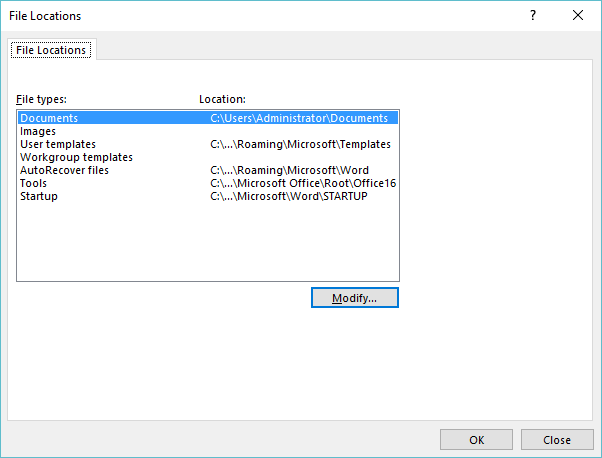Please Note: This article is written for users of the following Microsoft Word versions: 2007, 2010, 2013, 2016, 2019, and Word in Microsoft 365. If you are using an earlier version (Word 2003 or earlier), this tip may not work for you. For a version of this tip written specifically for earlier versions of Word, click here: Setting Your Default Document Directory.
Written by Allen Wyatt (last updated October 9, 2021)
This tip applies to Word 2007, 2010, 2013, 2016, 2019, and Word in Microsoft 365
Normally, Word starts looking for documents in the directory in which you started the program. If you want to change the default directory path, you can do so in the following manner:

Figure 1. The File Locations dialog box.
Note that this setting affects only the beginning directory used by Word to look for documents, before you do any opening and saving of documents. There are other actions you can take in Word that will affect the default directory proposed by the program. For instance, if you open a Word document that is in a folder different than the default one you set in step 6, and then you use Save As to save the document under a different name, the proposed directory will not match the one set in step 6. Instead, Word proposes to save the file in the same directory that the original document was stored in.
WordTips is your source for cost-effective Microsoft Word training. (Microsoft Word is the most popular word processing software in the world.) This tip (9591) applies to Microsoft Word 2007, 2010, 2013, 2016, 2019, and Word in Microsoft 365. You can find a version of this tip for the older menu interface of Word here: Setting Your Default Document Directory.

Do More in Less Time! Are you ready to harness the full power of Word 2013 to create professional documents? In this comprehensive guide you'll learn the skills and techniques for efficiently building the documents you need for your professional and your personal life. Check out Word 2013 In Depth today!
Got a bunch of info that is common to a lot of your documents? Here's a way to get that information standardized among ...
Discover MoreBy default Word dutifully keeps track of the different files you've worked on in the past. If you want to delete an entry ...
Discover MoreSave a document for the first time, and Word helpfully suggests a filename you can use or change. If you want this ...
Discover MoreFREE SERVICE: Get tips like this every week in WordTips, a free productivity newsletter. Enter your address and click "Subscribe."
2021-10-11 13:33:40
Miles Motture
Hi, love your site!
How do you do this for Word 365 for Mac?
Got a version of Word that uses the ribbon interface (Word 2007 or later)? This site is for you! If you use an earlier version of Word, visit our WordTips site focusing on the menu interface.
Visit the WordTips channel on YouTube
FREE SERVICE: Get tips like this every week in WordTips, a free productivity newsletter. Enter your address and click "Subscribe."
Copyright © 2024 Sharon Parq Associates, Inc.
Comments